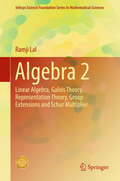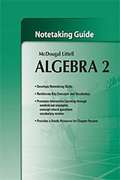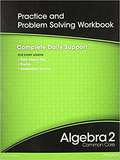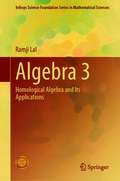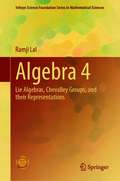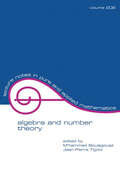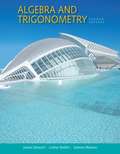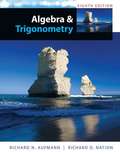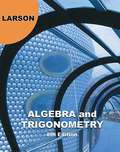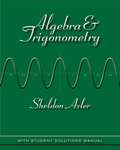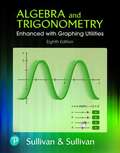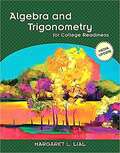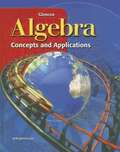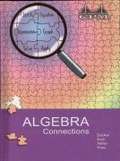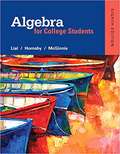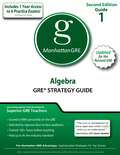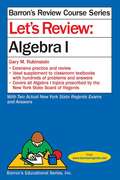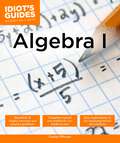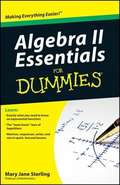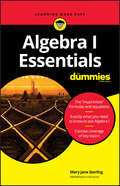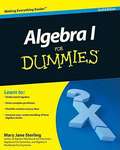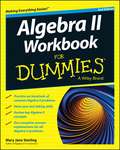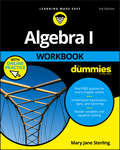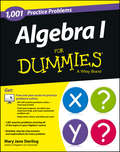- Table View
- List View
Algebra 2: Linear Algebra, Galois Theory, Representation theory, Group extensions and Schur Multiplier (Infosys Science Foundation Series)
by Ramji LalThis is the second in a series of three volumes dealing with important topics in algebra. Volume 2 is an introduction to linear algebra (including linear algebra over rings), Galois theory, representation theory, and the theory of group extensions. The section on linear algebra (chapters 1-5) does not require any background material from Algebra 1, except an understanding of set theory. Linear algebra is the most applicable branch of mathematics, and it is essential for students of science and engineering As such, the text can be used for one-semester courses for these students. The remaining part of the volume discusses Jordan and rational forms, general linear algebra (linear algebra over rings), Galois theory, representation theory (linear algebra over group algebras), and the theory of extension of groups follow linear algebra, and is suitable as a text for the second and third year students specializing in mathematics.
Algebra 2: Practice and Problem Solving Workbook
by Prentice-HallAlgebra 2 Practice and Problem Solving Workbook.
Algebra 3: Homological Algebra and Its Applications (Infosys Science Foundation Series)
by Ramji LalThis book, the third book in the four-volume series in algebra, deals with important topics in homological algebra, including abstract theory of derived functors, sheaf co-homology, and an introduction to etale and l-adic co-homology. It contains four chapters which discuss homology theory in an abelian category together with some important and fundamental applications in geometry, topology, algebraic geometry (including basics in abstract algebraic geometry), and group theory. The book will be of value to graduate and higher undergraduate students specializing in any branch of mathematics. The author has tried to make the book self-contained by introducing relevant concepts and results required. Prerequisite knowledge of the basics of algebra, linear algebra, topology, and calculus of several variables will be useful.
Algebra 4: Lie Algebras, Chevalley Groups, and Their Representations (Infosys Science Foundation Series)
by Ramji LalThis book, the fourth book in the four-volume series in algebra, discusses Lie algebra and representation theory in detail. It covers topics such as semisimple Lie algebras, root systems, representation theory of Lie algebra, Chevalley groups and representation theory of Chevalley groups. Numerous motivating illustrations have been presented along with exercises, enabling readers to acquire a good understanding of topics which they can then use to find the exact or most realistic solutions to their problems.
Algebra And Number Theory
by Jean-Pierre Tignol M'Hammed BoulagouazThis study demonstrates the key manipulations surrounding Brauer groups, graded rings, group representations, ideal classes of number fields, p-adic differential equations, and rationality problems of invariant fields - displaying a command of the most advanced methods in algebra. It describes new developments in noncommutative valuation theory and
Algebra And Trigonometry
by James Stewart Lothar Redlin Saleem WatsonThis bestselling author team explains concepts simply and clearly, without glossing over difficult points. Problem solving and mathematical modeling are introduced early and reinforced throughout, providing students with a solid foundation in the principles of mathematical thinking. Comprehensive and evenly paced, the book provides complete coverage of the function concept, and integrates a significant amount of graphing calculator material to help students develop insight into mathematical ideas. The authors' attention to detail and clarity--the same as found in James Stewart's market-leading Calculus book--is what makes this book the market leader.
Algebra And Trigonometry
by Richard Aufmann Richard NationThe text also includes technology features to accommodate courses that allow the option of using graphing calculators. The authors' proven Aufmann Interactive Method allows students to try a skill as it is presented in example form.
Algebra And Trigonometry
by Ron LarsonThis market-leading text continues to provide students and instructors with sound, consistently structured explanations of the mathematical concepts. <P><P>Designed for a two-term course, the new Eighth Edition retains the features that have made Algebra and Trigonometry a complete solution for both students and instructors: interesting applications, cutting-edge design, and innovative technology combined with an abundance of carefully written exercises.
Algebra And Trigonometry
by Sheldon AxlerAxler Algebra & Trigonometry is written for the two semester course. The text provides students with the skill and understanding needed for their coursework and for participating as an educated citizen in a complex society. Axler Algebra & Trigonometry focuses on depth, not breadth of topics by exploring necessary topics in greater detail. Readers will benefit from the straightforward definitions and plentiful examples of complex concepts. The Student Solutions Manual is integrated at the end of every section. The proximity of the solutions encourages students to go back and read the main text as they are working through the problems and exercises. The inclusion of the manual also saves students money.
Algebra And Trigonometry Enhanced With Graphing Utilities
by Michael SullivanThe proven approach of Michael Sullivan and Michael Sullivan III focuses you on the fundamental skills needed for the algebra and trigonometry course: prepare for class, practice with homework, and review the concepts. Part of the Enhanced with Graphing Utilities Series, Algebra and Trigonometry Enhanced with Graphing Utilities fully integrates graphing utilities into topics, allowing you to explore mathematical concepts and encounter ideas usually studied in later courses. Many examples show solutions using algebra side by side with graphing techniques. In the 8th Edition, all exercises and examples in the text have been reviewed and updated as needed, and the authors have added new problem-solving and review features.
Algebra And Trigonometry For College Readiness
by Margaret L. Lial John HornsbyAlgebra and Trigonometry for College Readiness
Algebra Concepts and Applications
by Glencoe Mcgraw-HillAlgebra: Concepts and Applications is designed to help you learn algebra and apply it to the real world. Throughout the text, you will be given opportunities to make connections from concrete models to abstract concepts. The real-world photographs and realistic data will help you see algebra in your world. You will also have plenty of opportunities to review and use arithmetic and geometry concepts as you study algebra.
Algebra Connections, Version 3.1
by Leslie Dietiker Kevin Coffey Evra BaldingerNIMAC-sourced textbook
Algebra For College Students
by John Hornsby Margaret Lial Terry McGinnisThe Lial Developmental Algebra Series uses a teacherly writing style and a careful blend of skills development and conceptual questions to meet the unique needs of the developmental math student. The author team takes advantage of experiences in the classroom and an editing eye to offer one of the most well-rounded series available, written with the developmental learner in mind. In this revision, the team retains their hallmark writing style, and provides new features and resources to optimize student preparedness and conceptual understanding. The Lial program provides students with the perfect balance of skills and concepts for a student-friendly approach to math.
Algebra GRE Preparation Guide, 2nd Edition
by Manhattan Gre StaffThe Algebra GRE Preparation Guide covers algebra in all its various forms (and disguises) on the GRE. Master fundamental techniques and nuanced strategies to help you solve for unknown variables of every type.
Algebra I (Barron's Regents NY)
by Gary Rubinstein Barron's Educational Series StaffThis updated book prepares students for the new Algebra I (Common Core) exam. Let's Review Algebra I is an ideal companion to high school textbooks and covers all Algebra I topics prescribed by the New York State Board of Regents. Features include: In-depth Regents exam preparation, including two recent Algebra I Regents exams and answer keys Easy to read topic summaries Step-by-step demonstrations and examples Review of all Algebra I topics Hundreds of sample questions with fully explained answers for practice and review, and more. Teachers can also use this book to plan lessons and as a helpful resource for practice, homework, and test questions.
Algebra I (Idiot's Guides)
by Carolyn WheaterStarting with the very basics and reinforcing concepts with practice and tips along the way, Idiot's Guides: Algebra I makes a complex subject easier to grasp and helps students and adult learners clear the hurdle that can stand between them and their academic goals. Special sidebars point out the reasoning behind the techniques (part of essential Common Core instruction) and a separate workbook section offers extra practice problems.
Algebra I Essentials For Dummies
by Mary Jane SterlingWith its use of multiple variables, functions, and formulas algebra can be confusing and overwhelming to learn and easy to forget. Perfect for students who need to review or reference critical concepts, Algebra I Essentials For Dummies provides content focused on key topics only, with discrete explanations of critical concepts taught in a typical Algebra I course, from functions and FOILs to quadratic and linear equations. This guide is also a perfect reference for parents who need to review critical algebra concepts as they help students with homework assignments, as well as for adult learners headed back into the classroom who just need a refresher of the core concepts.The Essentials For Dummies SeriesDummies is proud to present our new series, The Essentials For Dummies. Now students who are prepping for exams, preparing to study new material, or who just need a refresher can have a concise, easy-to-understand review guide that covers an entire course by concentrating solely on the most important concepts. From algebra and chemistry to grammar and Spanish, our expert authors focus on the skills students most need to succeed in a subject.
Algebra I Essentials For Dummies
by Mary Jane SterlingAlgebra I Essentials For Dummies (9781119590965) was previously published as Algebra I Essentials For Dummies (9780470618349). While this version features a new Dummies cover and design, the content is the same as the prior release and should not be considered a new or updated product. With its use of multiple variables, functions, and formulas algebra can be confusing and overwhelming to learn and easy to forget. Perfect for students who need to review or reference critical concepts, Algebra I Essentials For Dummies provides content focused on key topics only, with discrete explanations of critical concepts taught in a typical Algebra I course, from functions and FOILs to quadratic and linear equations. This guide is also a perfect reference for parents who need to review critical algebra concepts as they help students with homework assignments, as well as for adult learners headed back into the classroom who just need a refresher of the core concepts. The Essentials For Dummies SeriesDummies is proud to present our new series, The Essentials For Dummies. Now students who are prepping for exams, preparing to study new material, or who just need a refresher can have a concise, easy-to-understand review guide that covers an entire course by concentrating solely on the most important concepts. From algebra and chemistry to grammar and Spanish, our expert authors focus on the skills students most need to succeed in a subject.
Algebra I For Dummies, 2nd Edition
by Mary Jane SterlingFactor fearlessly, conquer the quadratic formula, and solve linear equations There's no doubt that algebra can be easy to some while extremely challenging to others. If you're vexed by variables, Algebra I For Dummies, 2nd Edition provides the plain-English, easy-to-follow guidance you need to get the right solution every time! Now with 25% new and revised content, this easy-to-understand reference not only explains algebra in terms you can understand, but it also gives you the necessary tools to solve complex problems with confidence. You'll understand how to factor fearlessly, conquer the quadratic formula, and solve linear equations. Includes revised and updated examples and practice problems Provides explanations and practical examples that mirror today's teaching methods Other titles by Sterling: Algebra II For Dummies and Algebra Workbook For Dummies Whether you're currently enrolled in a high school or college algebra course or are just looking to brush-up your skills, Algebra I For Dummies, 2nd Edition gives you friendly and comprehensible guidance on this often difficult-to-grasp subject.
Algebra I Workbook For Dummies
by Mary Jane SterlingFrom signed numbers to story problems -- calculate equations with easePractice is the key to improving your algebra skills, and that's what this workbook is all about. This hands-on guide focuses on helping you solve the many types of algebra problems you'll encounter in a focused, step-by-step manner. With just enough refresher explanations before each set of problems, this workbook shows you how to work with fractions, exponents, factoring, linear and quadratic equations, inequalities, graphs, and more!100s of problems!Hundreds of practice exercises and helpful explanationsExplanations mirror teaching methods and classroom protocolsFocused, modular content presented in step-by-step lessonsPractice on hundreds of Algebra I problemsReview key concepts and formulasGet complete answer explanations for all problems
Algebra I Workbook For Dummies
by Mary Jane SterlingThe grade-saving Algebra I companion, with hundreds of additional practice problems online Algebra I Workbook For Dummies is your solution to the Algebra brain-block. With hundreds of practice and example problems mapped to the typical high school Algebra class, you'll crack the code in no time! Each problem includes a full explanation so you can see where you went wrong—or right—every step of the way. From fractions to FOIL and everything in between, this guide will help you grasp the fundamental concepts you'll use in every other math class you'll ever take. This new third edition includes access to an online test bank, where you'll find bonus chapter quizzes to help you test your understanding and pinpoint areas in need of review. Whether you're preparing for an exam or seeking a start-to-finish study aid, this workbook is your ticket to acing algebra. Master basic operations and properties to solve any problem Simplify expressions with confidence Conquer factoring and wrestle equations into submission Reinforce learning with online chapter quizzes Algebra I is a fundamentally important class. What you learn here will follow you throughout Algebra II, Trigonometry, Calculus, and beyond, including Chemistry, Physics, Biology, and more. Practice really does make perfect—and this guide provides plenty of it. Study, practice, and score high!
Algebra I: 1,001 Practice Problems For Dummies (+ Free Online Practice)
by Mary Jane Sterling1,001 Algebra I Practice Problems For DummiesPractice makes perfect--and helps deepen your understanding of algebra by solving problems1,001 Algebra I Practice Problems For Dummies, with free access to online practice problems, takes you beyond the instruction and guidance offered in Algebra I For Dummies, giving you 1,001 opportunities to practice solving problems from the major topics in algebra. You start with some basic operations, move on to algebraic properties, polynomials, and quadratic equations, and finish up with graphing. Every practice question includes not only a solution but a step-by-step explanation. From the book, go online and find:One year free subscription to all 1,001 practice problemsOn-the-go access any way you want it--from your computer, smart phone, or tabletMultiple choice questions on all you math course topicsPersonalized reports that track your progress and help show you where you need to study the mostCustomized practice sets for self-directed studyPractice problems categorized as easy, medium, or hardWhether you're studying algebra at the high school or college level, the practice problems in 1,001 Algebra I Practice Problems For Dummies give you a chance to practice and reinforce the skill s you learn in the classroom and help you refine your understanding of algebra. Note to readers: 1,001 Algebra I Practice Problems For Dummies, which only includes problems to solve, is a great companion to Algebra I For Dummies, 2nd Edition which offers complete instruction on all topics in a typical Algebra I course.

